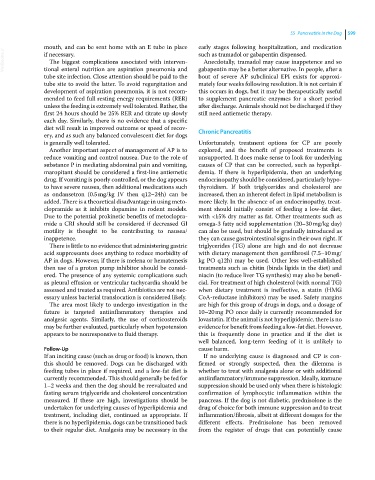Page 631 - Clinical Small Animal Internal Medicine
P. 631
55 Pancreatitis in the Dog 599
mouth, and can be sent home with an E tube in place early stages following hospitalization, and medication
VetBooks.ir if necessary. such as tramadol or gabapentin dispensed.
The biggest complications associated with interven-
Anecdotally, tramadol may cause inappetence and so
tional enteral nutrition are aspiration pneumonia and
bout of severe AP subclinical EPI exists for approxi-
tube site infection. Close attention should be paid to the gabapentin may be a better alternative. In people, after a
tube site to avoid the latter. To avoid regurgitation and mately four weeks following resolution. It is not certain if
development of aspiration pneumonia, it is not recom- this occurs in dogs, but it may be therapeutically useful
mended to feed full resting energy requirements (RER) to supplement pancreatic enzymes for a short period
unless the feeding is extremely well tolerated. Rather, the after discharge. Animals should not be discharged if they
first 24 hours should be 25% RER and titrate up slowly still need antiemetic therapy.
each day. Similarly, there is no evidence that a specific
diet will result in improved outcome or speed of recov- Chronic Pancreatitis
ery, and as such any balanced convalescent diet for dogs
is generally well tolerated. Unfortunately, treatment options for CP are poorly
Another important aspect of management of AP is to explored, and the benefit of proposed treatments is
reduce vomiting and control nausea. Due to the role of unsupported. It does make sense to look for underlying
substance P in mediating abdominal pain and vomiting, causes of CP that can be corrected, such as hyperlipi-
maropitant should be considered a first‐line antiemetic demia. If there is hyperlipidemia, then an underlying
drug. If vomiting is poorly controlled, or the dog appears endocrinopathy should be considered, particularly hypo-
to have severe nausea, then additional medications such thyroidism. If both triglycerides and cholesterol are
as ondansetron (0.5 mg/kg IV then q12–24h) can be increased, then an inherent defect in lipid metabolism is
added. There is a theoretical disadvantage in using meto- more likely. In the absence of an endocrinopathy, treat-
clopramide as it inhibits dopamine in rodent models. ment should initially consist of feeding a low‐fat diet,
Due to the potential prokinetic benefits of metoclopra- with <15% dry matter as fat. Other treatments such as
mide a CRI should still be considered if decreased GI omega‐3 fatty acid supplementation (20–30 mg/kg day)
motility is thought to be contributing to nausea/ can also be used, but should be gradually introduced as
inappetence. they can cause gastrointestinal signs in their own right. If
There is little to no evidence that administering gastric triglycerides (TG) alone are high and do not decrease
acid suppressants does anything to reduce morbidity of with dietary management then gemfibrosil (7.5–10 mg/
AP in dogs. However, if there is melena or hematemesis kg PO q12h) may be used. Other less well‐established
then use of a proton pump inhibitor should be consid- treatments such as chitin (binds lipids in the diet) and
ered. The presence of any systemic complications such niacin (to reduce liver TG synthesis) may also be benefi-
as pleural effusion or ventricular tachycardia should be cial. For treatment of high cholesterol (with normal TG)
assessed and treated as required. Antibiotics are not nec- when dietary treatment is ineffective, a statin (HMG
essary unless bacterial translocation is considered likely. CoA‐reductase inhibitors) may be used. Safety margins
The area most likely to undergo investigation in the are high for this group of drugs in dogs, and a dosage of
future is targeted antiinflammatory therapies and 10–20 mg PO once daily is currently recommended for
analgesic agents. Similarly, the use of corticosteroids lovastatin. If the animal is not hyperlipidemic, there is no
may be further evaluated, particularly when hypotension evidence for benefit from feeding a low‐fat diet. However,
appears to be nonresponsive to fluid therapy. this is frequently done in practice and if the diet is
well balanced, long‐term feeding of it is unlikely to
Follow‐Up cause harm.
If an inciting cause (such as drug or food) is known, then If no underlying cause is diagnosed and CP is con-
this should be removed. Dogs can be discharged with firmed or strongly suspected, then the dilemma is
feeding tubes in place if required, and a low‐fat diet is whether to treat with analgesia alone or with additional
currently recommended. This should generally be fed for antiinflammatory/immune suppression. Ideally, immune
1–2 weeks and then the dog should be reevaluated and suppression should be used only when there is histologic
fasting serum triglyceride and cholesterol concentration confirmation of lymphocytic inflammation within the
measured. If these are high, investigations should be pancreas. If the dog is not diabetic, prednisolone is the
undertaken for underlying causes of hyperlipidemia and drug of choice for both immune suppression and to treat
treatment, including diet, continued as appropriate. If inflammation/fibrosis, albeit at different dosages for the
there is no hyperlipidemia, dogs can be transitioned back different effects. Prednisolone has been removed
to their regular diet. Analgesia may be necessary in the from the register of drugs that can potentially cause

